This document answers the most important questions
connected with billing:
Billing profile is the collection of details used to
contact you on financial or related matters. You can have
several billing profiles and use them in turn, activating
the one you would like to be charged.
You can share one billing profile between your accounts, if
you have more than one. This means you can pay with one card
/ receive bills at one address for all your accounts.
Settings are configured individually for each billing
profile.
If you sign up as a trial user, no billing profile is
created. The system, however, keeps track of all your
purchases and includes them into your bills available in the
Online Invoice.
To receive invoices by email, do the following:
On the page that shows, click the OFF icon to Enable Receiving
the invoice by e-mail. With this option ON, you will receive invoices by
email.
When Do I Pay?
Upon the account activation, your new billing period opens. It defines WHEN
the system charges the fees. For fee types see Online
Price.
A new billing period opens:
- when your account is activated after signup
- when your suspended account gets resumed
- when you switch to another plan
- when you change your billing period
A billing period closes:
- when you quit hosting
- when your account gets suspended
- when you switch to another plan
- when you change your billing period
What Do I Pay For?
To see your plan's prices, select Online Price in the Billing
menu. The following table will appear
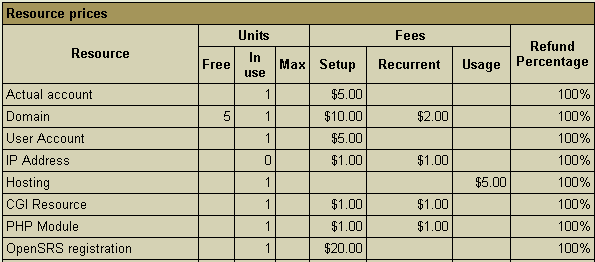
- Free: the minimum number of units you initially get for free.
- In Use: the number of units you are currently using.
- Max: the maximum number of units you can have.
- Setup: single-time amount payable at the moment when a unit of
this specific resource is purchased beyond free units.
- Recurrent: the amount payable at the beginning of each payment
period for this type of resource. If a resource is purchased in the middle
of the payment interval, the recurrent fee is calculated for the period from
this moment to the end of the payment interval. Recurrent fee is refundable
adjusted for refund percentage (see below).
- Usage (i.e. extra): payment for every unit of this resource used
over the set quota. It is charged:
- at the end of each billing period;
- when you change to a different plan;
- when you delete this resource, in which case it is
calculated for the period from the beginning of the payment interval to the
moment of resource deletion or plan change.
Usage fee is nonrefundable.
- Refund Percentage: If you delete this
resource, you will be returned recurrent fee adjusted for the refund
percentage for the days left to the end of the current billing period when
you quit using the resource.
E.g.: Your billing period is 1 month long. It started on
November 1 and will be closed on November 30. Recurrent fee for dedicated IP
is $3. At the beginning of your billing period you were charged $3 for
dedicated IP. On November 10 you are switching to shared IP. With 10% refund
you will get back $0,2.
Refund is calculated according to the following formula:
money to be refunded = (recurrent fee x time left to
the closure of the billing period)/ duration of the billing period.
IMPORTANT: Refunds are not placed on credit card
accounts. Instead, money is either put on your hosting account balance or is
sent to you by check.
Empty Fees fields mean that nothing is charged for this resource. If
all fields for a specific resource are empty, this resource is completely
free.
Billing is the same for most resources. However, some resources have a
special nature that requires a different billing scheme:
|
Resource
|
Free
|
In Use
|
Max
|
Setup
|
Recurrent
|
Usage
|
Refund
|
|
Standard resources
|
Units that you get for free
|
Units you are currently using
|
Maximum number of units you can have
|
Charged when you purchase a new unit of this resource beyond free
units
|
Charged at the beginning of each billing period for each unit beyond
free units
|
Charged at the end of each billing period for each unit beyond free
units
|
% of the recurrent fee for the remaining part of the billing period
debited to your account when you cancel the resource
|
|
Dedicated IP Address
|
Number of dedicated IPs that you get for free
|
Number of dedicated IPs you are currently using
|
Maximum number of dedicated IPs you can have
|
Charged when you purchase a new dedicated IP beyond free units
|
Charged at the beginning of each billing period for each dedicated IP
beyond free units
|
Charged at the end of each billing period for each dedicated IP
beyond free units
|
% of the recurrent fee for the remaining part of the billing period
debited to your account when you switch to shared IP or otherwise cancel
this resource
|
|
OpenSRS
|
N/A
|
Domains registered with OpenSRS
|
N/A
|
The cost of domain registration for 1 year
|
N/A
|
N/A
|
% of the prorated recurrent fee for the remaining part of the billing
period debited to your registration with OpenSRS
|
|
Web quota
Mail quota
Real quota
|
MB of disk space that you get for free
|
MB of disk space that you are currently subscribed for. The size of
your web site must be smaller than web disk quota by at least a couple
of megabytes to ensure correct performance of web statistics packages,
such as Webalizer or ModLogAn
|
MB of disk space you can have. For web quota, this amount includes
both your web site and web statistics files
|
N/A
|
Charged at the beginning of the billing period for the difference
between the limit and the free units
|
Charged at the end of the billing period for the amount used beyond
free units
|
% of the recurrent fee for the remaining part of the billing period
debited to your account for each canceled megabyte of disk quota
|
|
Traffic
(all kinds)
|
GB of traffic you don't pay for
|
Prorated GB of traffic booked for the current billing month. The
billing month can start on any day of the calendar month
|
N/A
|
N/A
|
Charged once at the beginning of the billing period for the
difference between the limit and the free units. This is what you pay
for 1 GB of additionally booked traffic
|
Charged at the end of each month of the billing period for the
prorated amount you run up beyond the limit
|
% of the recurrent fee for the remaining part of the whole billing
period
|
|
MySQL/ PGSQL
db quota
|
MB of database disk space you get for free
|
MB of database space that you are currently subscribed for
|
MB of database space you can have
|
N/A
|
Charged once at the beginning of the billing period for the
difference between the limit and the free units
|
Charged at the end of each month of the billing period for the amount
you use beyond the limit.
|
% of the recurrent fee for the remaining part of the billing period
debited to your account for each canceled megabyte of database quota
|
|
MS SQL
db quota
|
MB of database disk space that you get for free
|
MB of database space that you are currently subscribed for. The size
of all your MS SQL databases can take no more than half of the MS SQL
database quota, leaving the rest of the space for transaction logs
|
MB of MS SQL database space you can have. This includes both your
databases and transaction log files
|
N/A
|
Charged once at the beginning of the billing period for the
difference between the limit and the free units
|
N/A
|
% of the recurrent fee for the remaining part of the billing period
debited to your account for each canceled megabyte of database quota
|
|
Real User
|
Simultaneous connections to RealServer that you get for free
|
Simultaneous connections to RealServer that you currently have
|
Simultaneous connections to RealServer that you can have
|
N/A
|
Charged at the beginning of the billing period for the difference
between the limit and the free units
|
N/A
|
% of the recurrent fee for the remaining part of the billing period
debited to your account when you cancel the resource
|
How do I view my billing history?
To see your charges by billing profiles for one account, select Online
Invoice in the Billing menu. An invoice consists of consequent
bills:
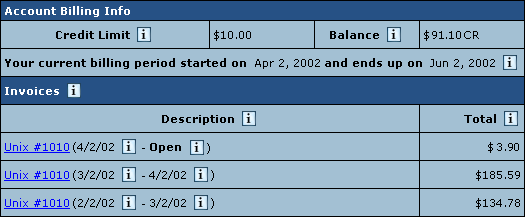
Balance shows how much money you have on your
balance. A negative balance shows how much you owe for the
services used. This is usually appropriate for users who pay
by check and for credit card users whose credit cards failed
to be charged.
Credit restricts your ability to buy new resources in
case your credit card fails to be charged or you have run
out of your 'check' money.
- Description: the name of your current account.
- Amount: the amount accrued for the billing period. This amount
consists of accruals for all resources, including the setup, recurrent and
usage fee. However, it does not include or depend on factual charges, nor is
it related to debits and credits to the account. For example, if you were
accrued $10 setup fee, the Amount will show $10.00, even if your
credit card has been immediately credited by this amount.
- From: the beginning of the payment period.
- To: the end of the payment period. In the example illustrated
above, Opened means that the billing period has not finished.
A new bill is created for every new payment interval The initial setup fee
is put in a separate bill.
To view details of any bill in the invoice, click its Description in the
first column. The picture below illustrates details of the initial setup
bill:
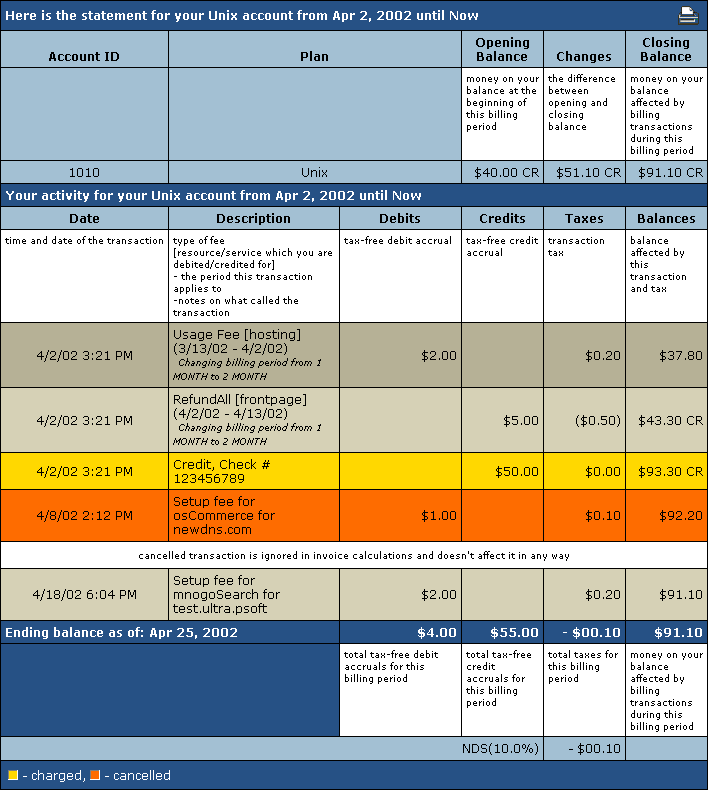
Total shows the amount due for factual services
offered. It does not include most of the items highlighted
by yellow, such as items that were immediately charged off
the credit card, credits or debits to the account balance by
the administrator, etc.
*To get a printable version of your bill, click the Printer icon in the
bill header which will open it in a separate window suitable for immediate
printout (version 2.08 and higher).
How Do I View My Overall Charges?
To view charges for all your accounts, select Online Sum invoice in
the Billing menu then select the billing profile. If you are just
starting with your account, you will see something like this:
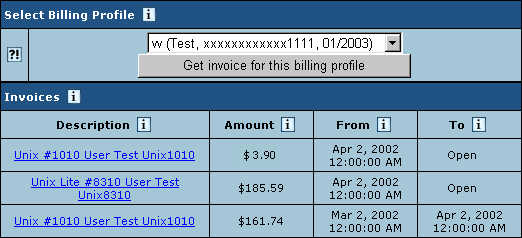
Select the profile from the box and press the Get Invoice
button.
The Online Summary Invoice page will display your bills for all accounts.
How do I become a pay user?
If you are a trial user, you will get this window at the end of the trial
period:
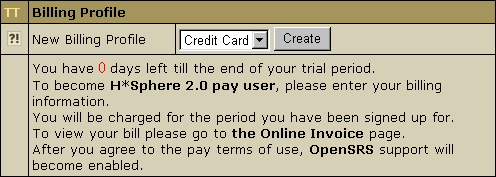
This means you need to become a pay user. For this, all you need to do is
create a billing profile using the Billing Profile utility.
- Check payments: You need to send a check payment for the amount
due plus, if possible, an amount to cover possible future costs. After the
administrator receives your payment and credits it to your account, you will
become a pay user.
- Credit card payments: If the credit card is valid, the
outstanding amount is charged, and you will become a pay user.
In either case, if the account was suspended, it resumes.
How Can I Get My Money Back?
When using H-Sphere, you can claim all your recurrent and usage payments
back if you decide to quit hosting during the Money Back period. Mind that
the setup fees for any resources will not be returned.
Not all plans allow to claim money back. To find out whether this feature
is available under a plan, go to the signup/login page and click the link
that says: To compare available hosting plans and price schemes, please
click here. In the form that appears, check the boxes to the plans you
want to compare or click the Plan group link to compare grouped plans and
their price schemes. In the first section of the chart that appears find
Money Back Guarantee.
To claim the money back, click Money Back on the control panel home
page. The following page will appear:

After you click the first link, your
account will be suspended:
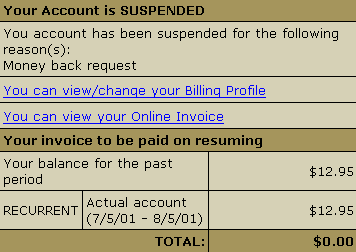
The amount due will be sent by check to the address you specified
in the Billing Info.




